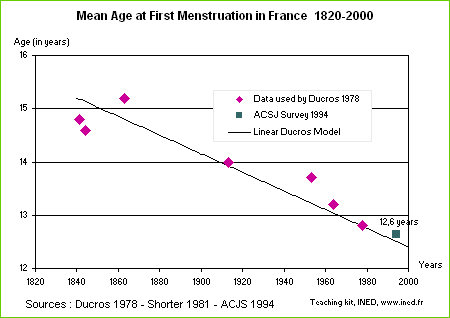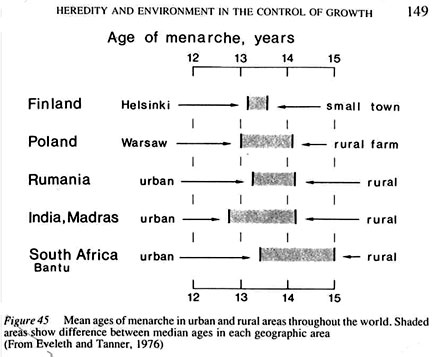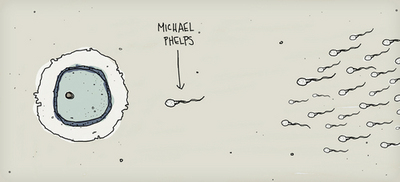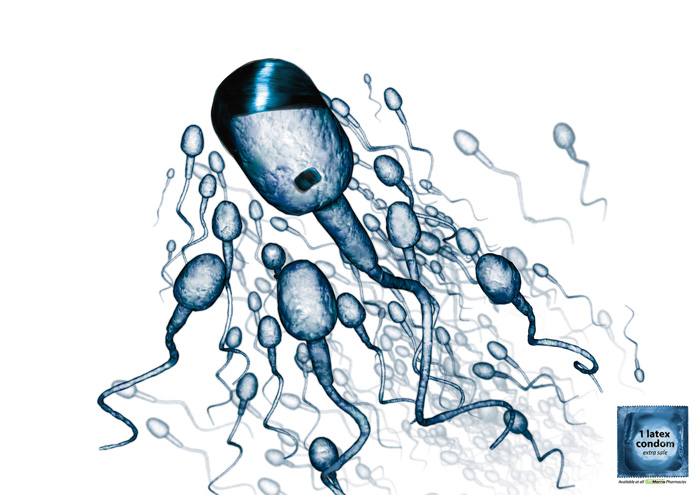One topic we cover in my sociology classes is the way the nature vs. nurture debate treats those two categories as though they are completely separate entities: “nature” is this fixed biological reality and “nurture” is all the social stuff we use to tinker around with nature as best we can. I point out to students that biology isn’t as fixed as we often think it is, and that seemingly “natural” processes are in fact often highly influenced by social factors.
One good example of this is the age at which girls have their first periods (menarche). In the U.S. today, the average age at menarche is a little over 12 years (see source here), and that seems normal to us. But historically, this is odd; until quite recently, girls did not begin menstruating until well into their teens. Because girls have to develop a certain amount of body fat in order to menstruate, access to food affects age at menarche. And access to food is generally an indicator of all types of social factors, including societal wealth and the distribution of wealth within groups. In general, economic development increases access to sufficient levels of food, and thus reduces average age at menarche.
This graph of average age at menarche in France from 1840-2000 (found on the French National Institute for Demographic Studies website here) shows a clear decline, starting at over 15 years and now standing at under 13:
Below is a bar graph showing average age at menarche for a number of countries (found here; age at menarche is the grey bar); we see the oldest average age is 13 and a half years, in Germany. Note that the data are not all from the same year, and while most report mean age at menarche, some report median age, so though they show a general trend, they are not stricly comparable:
However, these average ages obscure the fact that access to resources is not equal within nations, and as we would expect, though average age at menarche has fallen for most nations over the past century, we continue to see differences in average age among groups within nations that seem to mirror differences in wealth. For instance, this graph (found at the Museum of Menstruation website here) shows differences in average age at menarche between urban and rural areas in several countries:
The example of the quite dramatic fall in average age at menarche, as well as continued differences within societies, is a very helpful example for getting across the idea that biology is not fixed. I explain to my students that though we have many biological processes (i.e., the ability to menstruate), social factors such as economic development and social inequality affect how many of those processes are expressed (i.e., how early girls being to menstruate, on average). For other examples of how social factors affect biology, see this post on average lifespan and this post on increases in height over time.
I’m currently pairing these images with the chapters “The Body’s New Timetable: How the Life Course of American Girls Has Changed” and “Sanitizing Puberty: The American Way to Menstruate” from The Body Project: An Intimate History of American Girls, by Joan Jacobs Brumberg (1997, NY: Vintage Books) in my women’s studies course. Brumberg argues that the decreasing age of menstruation has created new social pressures as there is an increasing gap between girls’ biological maturity (that is, being able to get pregnant at age 12 or so) and their mental and emotional maturity (they’re still 12 year old girls), a point activists were trying to make in these misguided PSAs about statutory rape. Brumberg argues that just as this was happening, American cultural understandings of menstruation turned it into a hygiene problem, not a maturational milestone, meaning we give girls information about tampons and sanitary pads but not much about what these changes really mean.
Just for fun, here is “The Story of Menstruation,” an animated cartoon put out by the Disney company in 1946. Millions of girls learned about menstruation from it in the ensuing decades, including that they could throwing their schedules off by getting too emotional or cold and that it’s ok to bathe as long as the water isn’t too hot or cold. It illustrates Brumberg’s point about how discusses of menstruation turned to scientific explanations of what was happening and advice about what was and wasn’t ok to do while menstruating, while mostly ignoring it’s emotional or social significance.
I also like the explanation at the beginning of why we refer to “Mother” nature–because she does all her work without anyone even noticing, just like moms. How nice.























